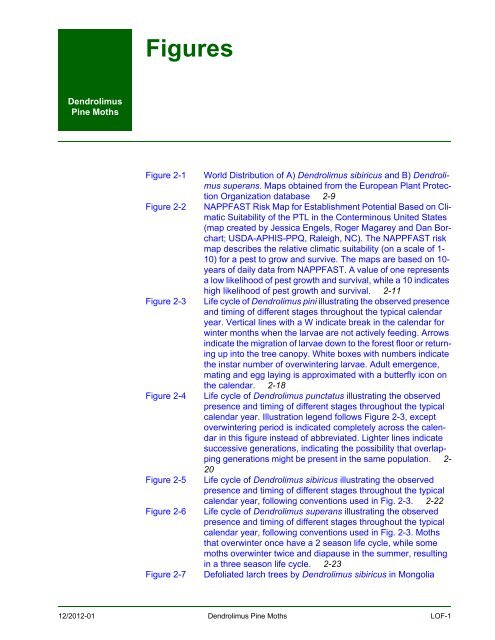New Pest Response Guidelines - aphis - US Department of Agriculture
New Pest Response Guidelines - aphis - US Department of Agriculture
New Pest Response Guidelines - aphis - US Department of Agriculture
Create successful ePaper yourself
Turn your PDF publications into a flip-book with our unique Google optimized e-Paper software.
Dendrolimus<br />
Pine Moths<br />
Figures<br />
Figure 2-1 World Distribution <strong>of</strong> A) Dendrolimus sibiricus and B) Dendrolimus<br />
superans. Maps obtained from the European Plant Protection<br />
Organization database 2-9<br />
Figure 2-2 NAPPFAST Risk Map for Establishment Potential Based on Climatic<br />
Suitability <strong>of</strong> the PTL in the Conterminous United States<br />
(map created by Jessica Engels, Roger Magarey and Dan Borchart;<br />
<strong>US</strong>DA-APHIS-PPQ, Raleigh, NC). The NAPPFAST risk<br />
map describes the relative climatic suitability (on a scale <strong>of</strong> 1-<br />
10) for a pest to grow and survive. The maps are based on 10years<br />
<strong>of</strong> daily data from NAPPFAST. A value <strong>of</strong> one represents<br />
a low likelihood <strong>of</strong> pest growth and survival, while a 10 indicates<br />
high likelihood <strong>of</strong> pest growth and survival. 2-11<br />
Figure 2-3 Life cycle <strong>of</strong> Dendrolimus pini illustrating the observed presence<br />
and timing <strong>of</strong> different stages throughout the typical calendar<br />
year. Vertical lines with a W indicate break in the calendar for<br />
winter months when the larvae are not actively feeding. Arrows<br />
indicate the migration <strong>of</strong> larvae down to the forest floor or returning<br />
up into the tree canopy. White boxes with numbers indicate<br />
the instar number <strong>of</strong> overwintering larvae. Adult emergence,<br />
mating and egg laying is approximated with a butterfly icon on<br />
the calendar. 2-18<br />
Figure 2-4 Life cycle <strong>of</strong> Dendrolimus punctatus illustrating the observed<br />
presence and timing <strong>of</strong> different stages throughout the typical<br />
calendar year. Illustration legend follows Figure 2-3, except<br />
overwintering period is indicated completely across the calendar<br />
in this figure instead <strong>of</strong> abbreviated. Lighter lines indicate<br />
successive generations, indicating the possibility that overlapping<br />
generations might be present in the same population. 2-<br />
20<br />
Figure 2-5 Life cycle <strong>of</strong> Dendrolimus sibiricus illustrating the observed<br />
presence and timing <strong>of</strong> different stages throughout the typical<br />
calendar year, following conventions used in Fig. 2-3. 2-22<br />
Figure 2-6 Life cycle <strong>of</strong> Dendrolimus superans illustrating the observed<br />
presence and timing <strong>of</strong> different stages throughout the typical<br />
calendar year, following conventions used in Fig. 2-3. Moths<br />
that overwinter once have a 2 season life cycle, while some<br />
moths overwinter twice and diapause in the summer, resulting<br />
in a three season life cycle. 2-23<br />
Figure 2-7 Defoliated larch trees by Dendrolimus sibiricus in Mongolia<br />
12/2012-01 Dendrolimus Pine Moths LOF-1

















